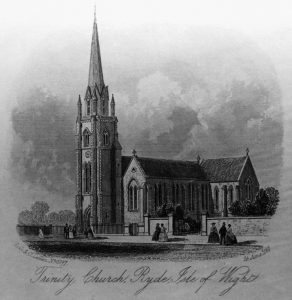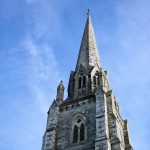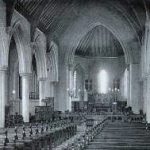Holy Trinity Church, Ryde

In 1839 when the Rev W Spencer Phillips BD was appointed vicar of the Parish of Newchurch, which included Ryde, he soon realised there was a need for a church in the town to serve the growing community. The population had grown from 1,601 in 1811 to 5,840 in 1841. He quickly appointed a committee to raise funds for the project, and in two years, raised £5,806 by voluntary contribution and grants from various societies.
On 14 October Elizabeth Lind laid the first stone on a plot of land she and her family had kindly donated in Dover Street, Ryde. They had also generously given £1,500 to the building fund.
Designed by local architect Thomas Hellyer in the Early English Style, the Church provided seating for 800 people. 500 of the seats were set apart for free sittings forever; the remaining 300 were to be let to provide a yearly allowance for the incumbent. This was a common practice in those days.
When local builders Messrs Langdon and Denham had built up the Church to street level, the project unfortunately came to a halt due to legal difficulties. The Honorary Lindsay Burrell, who was living in Ryde at the time, stood security for the cash required to continue, and another local builder, Thomas Dashwood, was employed to finish the project, including the tower and spire.
The Right Rev Charles Sumner DD, Bishop of Winchester, consecrated the Church on 28 October 1845, but it was still incomplete. There were no transepts and the spire was not finished until the following year when the Rev A J Wade MA, curate in charge, placed the final stone, the capstone, in position.
The Historical and Commercial Directory of 1871 notes, “the fine tower and spire affords an excellent landmark”. It is hard to believe today that once Holy Trinity overlooked fields of grazing cattle. The London Gazette dated 26 May 1846, reported a district had been assigned to the new Church, and called The Chaplery District of the Holy Trinity, Ryde. The Church remained part of the Parish of Newchurch until 1863, when under the provision of the New Parishes Act of 1856, it became the Parish of Holy Trinity, Ryde. The incumbent Rev A J Wade MA, who served the Church from 1845 to 1893, became the first Vicar.
In 1848, the Church began to take on its cruciform plan when the south transept was erected at the expense of Rev Wade, with the north transept following some twelve years later providing extra seating.
A special organ chamber, designed by local architect, Francis Newman, was built in 1871 at a cost of £286. The organ remained there until 1927 when it was rebuilt and enlarged by Messrs Morgan and Smith, of Hove, Sussex, and re-erected at the east end of the north aisle.
The font by the west door is octagonal and of Caen stone with carving on its sides, and supported by short stone columns. It was given by the Yard Family. The inscription in Roman lettering around the bowl is by John Keeble, the famous priest and writer of many hymns. Keeble College, Oxford is named in his memory. The South Chapel of St Martin contains the Parish memorial to those who fell in World War One.
The reredos, unveiled in 1922 by Major-General, John Edward Bernard Seeley, CB, CMG, DSO, Lord Lieutenant of Hampshire, show biblical heroes St Martin, St Michael the Archangel, St Christopher and St George. The stained glass above depicts the Martyrdom of St Alban and St Stephen, kneeling on cushions representing the Isle of Wight. Installed in 1966 through the generosity of the congregation, it was designed by Francis Skeat, of Harpenden, Hertfordshire.
The only surviving example of the glass that once filled the windows in this part of the Church is the trefoil high in the gable. The Church had a long association with the Jellicoe Family and the Union Jack in this Chapel was flown on HMS Iron Duke, flagship of the Admiral of the Fleet, Sir John (later Earl) Jellicoe and presented by his sister, Edith Lucy Jellicoe.
Close by is an unusual bronze wall tablet featuring a submarine, a memorial to Lieutenant Commander Paul Eddis, commander of the submarine “L24” sunk during manoeuvres on 10 January 1924 off Portland, Dorset.
The brass ewer by the font was given in memory of Lieutenant Edmund Henry Jellicoe RN, who died in 1904. In the north aisle is a memorial tablet in memory of Elizabeth Davies (wife of Commander Arthur Davies RN and niece of Lord Nelson), erected by her children.
Excerpt from RSHG’s book Ryde’s Heritage: Our Town, Your Histories published June 2008
- Holy Trinity Church spire, Dover Street, Ryde
- Holy Trinity Church interior 1907


